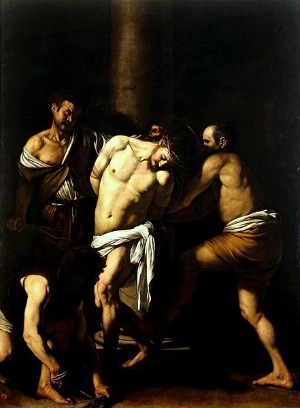Daily Caravaggio: The Flagellation
Caravaggio's depiction of torture reflects his own fear of execution

For the last four years of his life, Caravaggio was on the run under sentence of death. He became much obsessed with execution. It gave depictions of the deaths of saints and, in particular, of the torment of Christ a deep resonance for him--and for those of us lucky enough to see his paintings. To coincide with the UK paperback publication of my Caravaggio novel A NAME IN BLOOD, I'm posting each of the paintings that appear in the book each day this month along with a snippet from the novel. The Flagellation is in the Museo Nazionale di Capodimonte in Naples. You approach it through a series of other galleries whose doors line up with this astonishing image, so that it's truly inescapable. Unlike the other masterworks in the Capodimonte, Caravaggio's Flagellation has a room of its own, windowless and dark, like the dungeon where Jesus is tortured. Caravaggio spent a long time on the painting by his standards, and there's evidence of his revising it considerably, painting out a couple of figures, widening the canvas. Here's the point in A Name in Blood where Caravaggio finally gets it right:

For the last four years of his life, Caravaggio was on the run under sentence of death. He became much obsessed with execution. It gave depictions of the deaths of saints and, in particular, of the torment of Christ a deep resonance for him--and for those of us lucky enough to see his paintings. To coincide with the UK paperback publication of my Caravaggio novel A NAME IN BLOOD, I'm posting each of the paintings that appear in the book each day this month along with a snippet from the novel. The Flagellation is in the Museo Nazionale di Capodimonte in Naples. You approach it through a series of other galleries whose doors line up with this astonishing image, so that it's truly inescapable. Unlike the other masterworks in the Capodimonte, Caravaggio's Flagellation has a room of its own, windowless and dark, like the dungeon where Jesus is tortured. Caravaggio spent a long time on the painting by his standards, and there's evidence of his revising it considerably, painting out a couple of figures, widening the canvas. Here's the point in A Name in Blood where Caravaggio finally gets it right:
In the last light of the afternoon, he sat on a stool in his studio, slugging wine from a flask. There were still many touches he would need to make, but he had it now. The Flagellation was awash with cruelty and pain. It stank like a killing in a backstreet. He stared at the malicious pleasure on the face of the man at Jesus’s shoulder. He wondered if this was what people saw on his own face when rage overcame him. The thought shamed him.
Published on August 29, 2013 03:42
•
Tags:
art-history, caravaggio, covers, crime-fiction, food, historical-fiction, italy, rome
No comments have been added yet.



